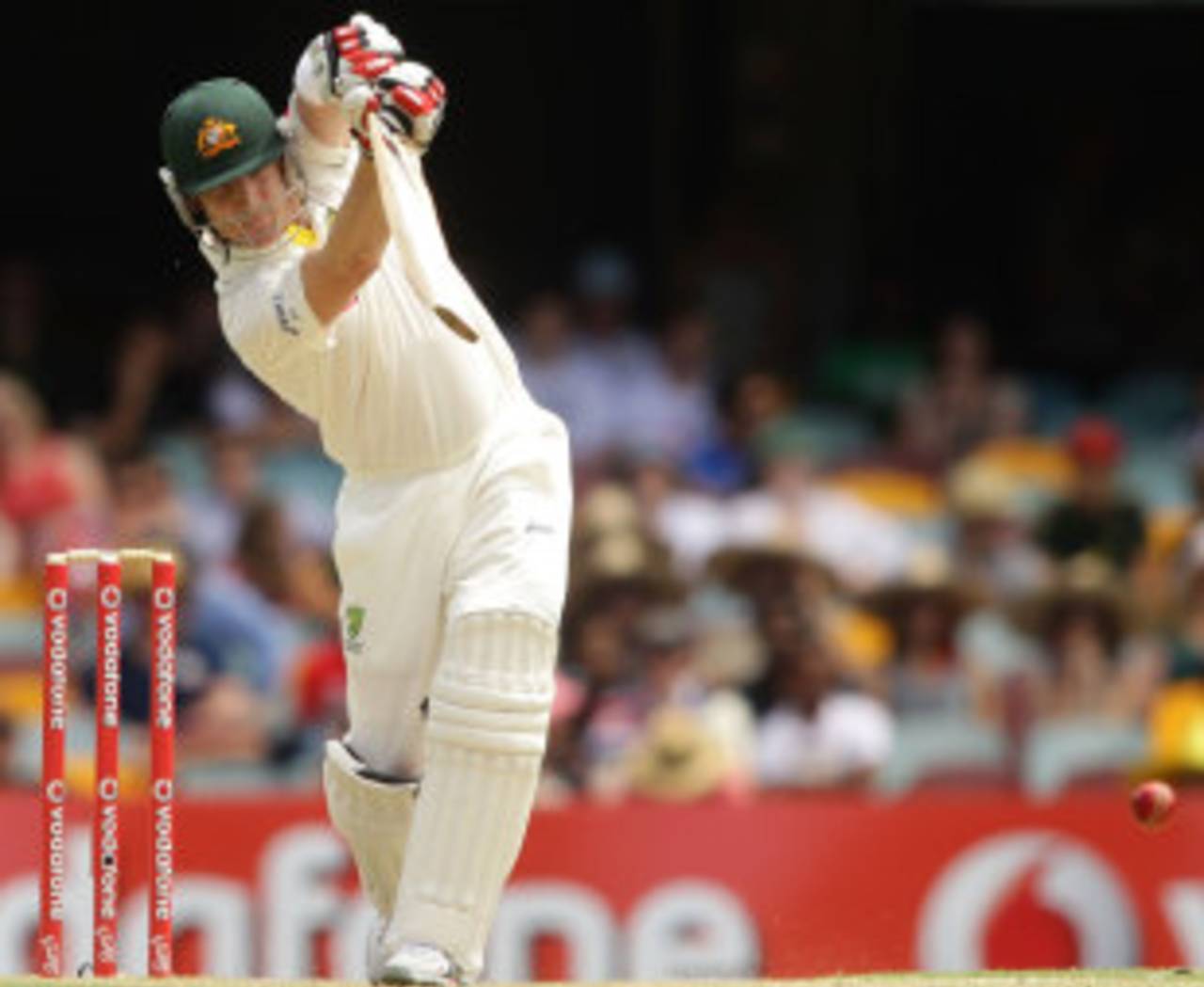If Australia's hellish defeat to South Africa
in Cape Town could be captured in a single moment, it was the stroke that dismissed
Brad Haddin. Advancing towards Vernon Philander even though his side was already in a precarious position on the second afternoon, Haddin aimed to carve a delivery offering neither length nor width, and edged wretchedly to his opposite number Mark Boucher. In that instant it felt impossible to view Haddin as anything other than a waster, deserving to be dropped, and as the match galloped away from the visitors the notion could only gather speed.
Yet three weeks later, here was Haddin in Brisbane, swelling his side's first innings against New Zealand with a chanceless 80 that was equal parts daring and discretion. He stretched the hosts' lead in the company of his captain Michael Clarke and then a motley collection of tail-enders. In between times, Haddin had proved his worth by contributing critically to the victory in Johannesburg, swatting a priceless 55. Of even greater significance was the fact that once the team returned home, the new selection panel named Haddin vice-captain for the Gabba.
Power and responsibility can do a variety of things to cricketers: building them up, tearing them down, or simply exhausting them. What is clear from Haddin's innings at the Gabba, as well as his lengthy playing career, is that this is a man lifted by a position of responsibility. When Haddin is thinking broadly of his team, his own batting shows a greater sense of awareness and balance, while still retaining the boldness and ball-striking that has had Australian crowds cooing regularly over the past few years. Granted the vice-captaincy, Haddin can still pierce the field with some of the crispest driving in the game, but he also appears more likely to choose the right ball with which to do it.
To draw such a conclusion from one innings would be instinctive, if not presumptuous. To sustain it beyond argument, it is necessary to look more deeply into Haddin's past, beyond his time in the Australian team. A fact often forgotten in the age of Simon Katich, Clarke and latterly Steve O'Keefe is that Haddin has been one of the most accomplished New South Wales captains of the past 20 years. Before the job was passed on to Katich, Haddin led the Blues with aggression, flair and plenty of courage, best epitomised by his performances at the ground on which he has now brought New Zealand to heel.
In four Sheffield Shield matches as captain of NSW at the Gabba between 2004 and 2006, at a time when Queensland counted bowlers like Andy Bichel, Michael Kasprowicz, Joe Dawes, Ashley Noffke and a young Watson among their number, Haddin's record is startling. Across those fixtures, often low-scoring on a seaming surface, he coshed 544 runs at 77.71, never reaching less than 41. Haddin's achievements in those matches were far more than statistical. Team-mates speak of how his courageous batting often lifted the team's morale as well as momentum, exuding the attitude that "these Bulls aren't so impossible to crack" and taking the team with him.
This was never more evident than in the 2005 Shield final, which NSW won breathlessly by a wicket. There were shades of Australia's Johannesburg chase about it. Haddin's 68 and 41 were his side's highest scores in each innings, and getting the visitors close enough for a tail-ender, Stuart MacGill, to scramble the winning runs.
Six years on, once Clarke had departed, Peter Siddle and James Pattinson swiftly followed. But Haddin's NSW team-mate Mitchell Starc responded to his senior's encouragement, building a partnership of strokes both chipper and chancy. While Starc had the time of his life, Haddin built soundly, picking off ones and twos, and twice sallying forth to thump sixes over straight midwicket. He ran the show with the assurance of a genuine leader.
As Australia's wicketkeeper of choice since 2008, Haddin has always been near the discussions of several captains, but only occasionally held formal office. He was not considered for the vice-captaincy when Michael Clarke replaced Ricky Ponting earlier this year, passed over for Shane Watson. The decision seemed largely to do with the selectors wanting a longer-term captaincy option in place should Clarke not pull himself out of the form trough that consumed his summer of 2010-11. There is also the habitual reluctance to make a wicketkeeper Australian captain.
Now, however, Watson is recovering from injury, and Clarke is in something like the form of his life. Haddin's response to leadership responsibility cannot have been lost on the national selector John Inverarity, as he continues his search for men of staunch character to build the Australian team around Clarke. Though Tim Paine and Matthew Wade are worthy successors to Haddin as a wicketkeeper, neither yet have the captaincy experience of the older man. The vice-captaincy was described by the Argus review as "an important role that should be more clearly defined".
Haddin should not be discounted as the man to serve under Clarke for the remainder of the summer, the shrewd lieutenant to a strong and natural captain. A similar dynamic worked soundly for Mark Taylor and Ian Healy during the first two and half years of the former's reign, despite Healy never being considered likely to ascend to the captaincy himself. At 34, Haddin will never do so either, yet on the evidence of Brisbane he has much more to give Australia as vice-captain than simply as batsman/wicketkeeper. The Cape Town shot will never be forgotten, of course, but a few more days like this will allow its memory to soften.
Daniel Brettig is an assistant editor at ESPNcricinfo

